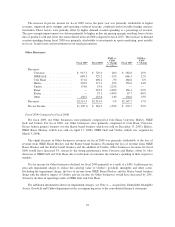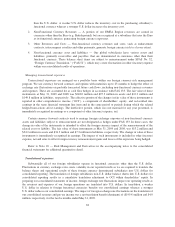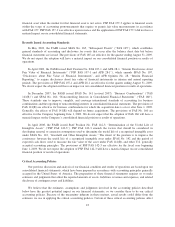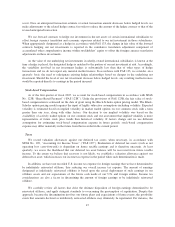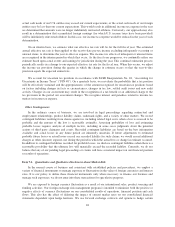Nike 2009 Annual Report Download - page 46
Download and view the complete annual report
Please find page 46 of the 2009 Nike annual report below. You can navigate through the pages in the report by either clicking on the pages listed below, or by using the keyword search tool below to find specific information within the annual report.working capital account balances, including the policies for revenue recognition, the allowance for uncollectible
accounts receivable, inventory reserves, and contingent payments under endorsement contracts. These policies
require that we make estimates in the preparation of our financial statements as of a given date. However, since
our business cycle is relatively short, actual results related to these estimates are generally known within the
six-month period following the financial statement date. Thus, these policies generally affect only the timing of
reported amounts across two to three fiscal quarters.
Within the context of these critical accounting policies, we are not currently aware of any reasonably likely
events or circumstances that would result in materially different amounts being reported.
Revenue Recognition
We record wholesale revenues when title passes and the risks and rewards of ownership have passed to the
customer, based on the terms of sale. Title passes generally upon shipment or upon receipt by the customer
depending on the country of the sale and the agreement with the customer. Retail store revenues are recorded at
the time of sale.
In some instances, we ship product directly from our supplier to the customer and recognize revenue when
the product is delivered to and accepted by the customer. Our revenues may fluctuate in cases when our
customers delay accepting shipment of product for periods up to several weeks.
In certain countries outside of the U.S., precise information regarding the date of receipt by the customer is
not readily available. In these cases, we estimate the date of receipt by the customer based upon historical
delivery times by geographic location. On the basis of our tests of actual transactions, we have no indication that
these estimates have been materially inaccurate historically.
As part of our revenue recognition policy, we record estimated sales returns and miscellaneous claims from
customers as reductions to revenues at the time revenues are recorded. We base our estimates on historical rates
of product returns and claims, and specific identification of outstanding claims and outstanding returns not yet
received from customers. Actual returns and claims in any future period are inherently uncertain and thus may
differ from our estimates. If actual or expected future returns and claims were significantly greater or lower than
the reserves we had established, we would record a reduction or increase to net revenues in the period in which
we made such determination.
Allowance for Uncollectible Accounts Receivable
We make ongoing estimates relating to the ability to collect our accounts receivable and maintain an
allowance for estimated losses resulting from the inability of our customers to make required payments. In
determining the amount of the allowance, we consider our historical level of credit losses and make judgments
about the creditworthiness of significant customers based on ongoing credit evaluations. Since we cannot predict
future changes in the financial stability of our customers, actual future losses from uncollectible accounts may
differ from our estimates. If the financial condition of our customers were to deteriorate, resulting in their
inability to make payments, a larger allowance might be required. In the event we determine that a smaller or
larger allowance is appropriate, we would record a credit or a charge to selling and administrative expense in the
period in which such a determination is made.
Inventory Reserves
We also make ongoing estimates relating to the net realizable value of inventories, based upon our
assumptions about future demand and market conditions. If we estimate that the net realizable value of our
inventory is less than the cost of the inventory recorded on our books, we record a reserve equal to the difference
between the cost of the inventory and the estimated net realizable value. This reserve is recorded as a charge to
44



